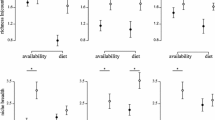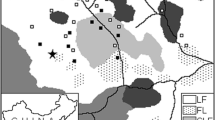Summary
The diets of five syntopic species of Ctenotus were examined over a two-year period on a 60 ha spinifex grassland site in central Australia. The aims of the study were to test predictions that termites were an important part of the food web for syntopic Ctenotus in spinifex grasslands, and to examine seasonal changes in prey use and dietary overlap between the species. Environmental conditions during the first season of the study were dry resulting in generally low invertebrate abundance. In contrast the second season was relatively moist and overall invertebrate abundance was higher than in the first season. Diets of five species of Ctenotus contained a range of terrestrial prey although one species (C. pantherinus) was relatively termite-specialized at all times. Dietary overlap at the ordinal level between the species was generally higher during dry periods when prey abundance was low, and higher for species-pairs that were similar in body size. During the driest period of the study most species of Ctenotus ate a high proportion of termite prey which accounted for the high dietary overlap. However, each species of Ctenotus consumed different genera or foraging guilds of termites. The results suggest that most of these lizards were opportunistic in their selection of prey but that during dry periods when prey are scarce, termites may play a significant role in supporting a high α-diversity of Ctenotus.
Similar content being viewed by others
References
Chesson J (1978) Measuring preference in selective predation. Ecology 59:211–215
Churchfield S (1980) Subterranean foraging and burrowing activity of the common shrew. Acta Theriol 25:451–459
Cloudsley Thompson JL, Idris BEM (1964) The insect fauna of the desert near Khartoum: seasonal fluctuations and the effect of grazing. Proc Roy Entom Soc London Ser A 39:41–46
Cogger HG (1984) Reptiles in the Australian arid zone. In: Cogger HG, Cameron EE (eds) Arid Australia. Australian Museum, Sydney, pp 235–252
Common IFB (1970) Lepidoptera (Moths and butterflies). CSIRO, pp 765–866
CSIRO (1970) Insects of Australia. Melbourne University Press, Melbourne Australia
Dickman CR (1983) Dusky antechinus, Antechinus swainsonii. In: Strahan R (ed) Complete Book of Australian Mammals. Angus and Robertson, Sydney Australia, pp 46–47
Dunham AE (1983) Realized niche overlap, resource abundance and intensity of interspecific competition in a guild of iguanid lizards. In: Huey RB, Pianka ER, Schoener TW (eds) Lizard Ecology: Studies on a Model Organism. Harvard University Press, Cambridge Massachusetts, pp 261–280
Gay FJ (1970) Isoptera. CSIRO, pp 275–293
Greenslade P, Greenslade PJM (1971) The use of baits and preservatives in pitfall traps. J Aust Entom Soc 10:253–260
Henle K (1988) Population ecology and life history of a lizard community in arid Australia. PhD Thesis, Australian National University, Canberra Australia
James CD (1989) Comparative ecology of sympatric scincid lizards (Ctenotus) in spinifex grasslands of central Australia. PhD Thesis, Sydney University, Sydney Australia
James CD (1991) A refinement of the stomach-flushing technique for small scincid lizards. Herp Rev (in press)
Johnson KA, Whitford WG (1975) Foraging ecology and relative importance of subterranean termites in Chihuahuan Desert ecosystems. Environ Entomol 4:66–70
Lack D (1946) Competition for food by birds of prey. J Anim Ecol 15:123–129
Legler JM, Sullivan LJ (1979) The application of stomach-flushing to lizards and anurans. Herpetologica 35:107–110
Luff ML (1968) Some effects of formalin on the numbers of Coleoptera caught in pitfall traps. Entomol Mon Mag 104:115–116
Mabbutt JA (1962) Geomorphology of the Alice Springs area. CSIRO Land Res Ser 6:163–184
MacArthur RH, Levins R (1967) The limiting similarity, convergence and divergence of coexisting species. Am Nat 101:377–385
M'Closkey RT (1976) Community structure in sympatric rodents. Ecology 57:728–739
Medica PA (1967) Food habits, habitat preference, reproduction and diurnal activity in four sympatric species of whiptail lizards (Cnemidophorus) in south central New Mexico. Bull Southern Calif Acad Sci 66:251–276
Milstead WW (1957) Observations on the natural history of four species of whiptail lizard, Cnemidophorus (Sauria: Teiidae) in Trans-Pecos Texas. Southwest Nat 2:105–121
Mitchell JA (1979) Ecology of southeastern Arizona whiptail lizards (Cnemidophorus: Teiidae): population densities, resource partitioning, and niche overlap. Can J Zool 57:1487–1499
Moore BP (1966) Isolation of the scent-trail pheromone of an Australian termite. Nature 211:746–747
Morton SR, James CD (1988) The diversity and abundance of lizards in arid Australia: a new hypothesis. Am Nat 132:237–256
Pianka ER (1969a) Habitat specificity, speciation, and species density in Australian desert lizards. Ecology 50:498–502
Pianka ER (1969b) Sympatry of desert lizards (Ctenotus) in Western Australia. Ecology 50:1012–1030
Pianka ER (1970) Comparative autecology of the lizard Cnemidophorus tigris in different parts of its geographic range. Ecology 51:703–720
Pianka ER (1973) The structure of lizard communities. Ann Rev Ecol Syst 4:53–74
Pianka ER (1986) Ecology and Natural History of Desert Lizards. Princeton University Press, Princeton New Jersey
Pianka ER (1989) Desert lizard diversity: additional comments and some data. Am Nat 134:344–364
Pimm SL (1983) Monte Carlo analyses in ecology. In: Huey RB, Pianka ER, Schoener TW (eds) Lizard Ecology: Studies on a Model Organism. Harvard University Press, Cambridge Massachusetts, pp 290–296
Schoener TW (1974) Resource partitioning in ecological communities. Science 185:27–39
Schoener TW (1982) The controversy over interspecific competition. Am Sci 70:586–595
Schoener TW (1989) Should hindgut contents be included in lizard dietary compilations? J Herpetol 23:455–458
Schoener TW, Gorman GC (1968) Some niche differences in three Lesser Antillean lizards of the genus Anolis. Ecology 49:819–830
Simpson G (1949) Measurement of diversity. Nature 163:688
Slatyer RO (1962) Climate of the Alice Springs area. CSIRO Land Res Ser 6:109–128
Stafford Smith and Morton (1990) A framework for the ecology of arid Australia. J Arid Environ 18:255–278
Watson JAL (1969) Schedorhinotermes derosus, a harvester termite in northern Australia (Isoptera: Rhinotermitidae). Insect Sociaux, Paris 16:173–178
Watson JAL (1982) Distribution, biology and speciation in the Australian harvester termites, Drepanotermes (Isoptera: Termitinae). In: Barker WR, Greenslade PJM (eds) Evolution of the Flora and Fauna of Arid Australia. Peacock Publications, Adelaide, pp 263–265
Watson JAL, Perry DH (1981) The Australian harvester termites of the genus Drepanotermes (Isoptera: Termitinae). Aust J Zool Suppl Ser 78:1–153
Whitford WG, Creusere FM (1977) Seasonal and yearly fluctuations in Chihuahuan Desert lizard communities. Herpetologica 33:54–65
Author information
Authors and Affiliations
Rights and permissions
About this article
Cite this article
James, C.D. Temporal variation in diets and trophic partitioning by coexisting lizards (Ctenotus: Scincidae) in central Australia. Oecologia 85, 553–561 (1991). https://doi.org/10.1007/BF00323768
Received:
Accepted:
Issue Date:
DOI: https://doi.org/10.1007/BF00323768




